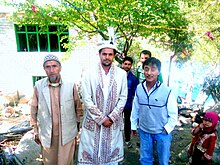
Back Şina (xalq) Azerbaijani Šina Croatian Suku Shina ID Shina (popolo) Italian シナー人 Japanese Шина (халық) Kazakh 시나족 Korean Šinai Lithuanian Шина (народ) Russian Shina people SIMPLE
 Shina people in Kargil | |
| Total population | |
|---|---|
| c. 1,178,400 including Kohistani, Shina[1][2] | |
| Regions with significant populations | |
| 1,146,000 (2018)[1][2] | |
| 32,247 (2011)[3] | |
| Languages | |
| Shina Urdu, serving as the lingua franca and widely understood as a second language[4][5] | |
| Religion | |
| Predominantly: Islam[6] | |
| Related ethnic groups | |
| Other Indo-Aryan peoples | |
The Shina (Shina: ݜݨیاٗ, Ṣiṇyaá) or Gilgitis[7] are an Indo-Aryan ethnolinguistic group[8] primarily residing in Gilgit–Baltistan and Indus Kohistan in Pakistan, as well as in the Dras Valley and Kishenganga Valley (Gurez) in the northern region of Jammu and Kashmir and Ladakh in India.[9] They speak an Indo-Aryan language, called Shina and their geographic area of predominance is referred to as Shenaki.
- ^ a b "Shina". Ethnologue. Archived from the original on 6 June 2019. Retrieved 25 June 2019.
- ^ a b "Shina, Kohistani". Ethnologue. Retrieved 22 May 2022.
- ^ "Abstract of speakers' strength of languages and mother tongues - 2011" (PDF).
- ^ "The Impact of Dominant Languages on Regional Languages: A Case Study of English, Urdu and Shina" (PDF). September 2020.
The researchers have observed that like every living language, Shina is rapidly changing due to its contact with Urdu and English. In schools and colleges of Gilgit-Baltistan, the medium of instruction is either Urdu or English from primary level to the higher level in universities, so the students have to learn both English and Urdu from the beginning. Moreover, Urdu is used as a lingua franca in the entire region as people from different linguistic backgrounds like Balti, Khowar, Wakhi and Brushashki communicate with each other in Urdu. Urdu is also used for trade purposes and by tourists from other parts of the country.
- ^ Buddruss, Georg; Zia, Mohammad Amin; Degener, Almuth (2012). The Meeting Place: Radio Features in the Shina Language of Gilgit by Mohammad Amin Zia : Text, Interlinear Analysis and English Translation with a Glossary. Harrassowitz. ISBN 978-3-447-06673-0.
Shina is an Indo-Aryan language of the Dardic group which is spoken in several dialect groups in Northern Pakistan. The variety spoken in the fertile valley of the Gilgit River is known as Gilgiti Shina, as the greatest number of speakers live in and around Gilgit town. While Gilgit is a multicultural and multilingual place, Shina is the language used in the homes of the majority of the inhabitants. Most speakers use Shina as a spoken language, especially for private purposes, while Urdu is the first choice as a medium for writing and as a lingua franca current throughout Pakistan.
- ^ Cite error: The named reference
CPS2016was invoked but never defined (see the help page). - ^ Minahan, James (30 May 2002). Encyclopedia of the Stateless Nations: Ethnic and National Groups Around the World A-Z [4 Volumes]. ABC-CLIO. p. 243. ISBN 978-0-313-07696-1.
The Shins (Shina), or Gilgitis, are the largest of several distinct ethnic groups in Gilgit.
- ^ Hastings, James; Selbie, John Alexander (1917). Encyclopaedia of Religion and Ethics: Mundas-Phrygians. C. Scribner's Sons. p. 606.
But the Shins have the characteristic Hindu aversion to eating the flesh of milk (or even ghī made from the milk) of the cow, and eschew fowls and fish. The former language of the people was Sanskrit, and the dialect now in use is called Shina. The basic element in the people is thus probably Indo-Aryan, and their festivals preserve many traces of Hindu beliefs.
- ^ Jain, Danesh; Cardona, George (26 July 2007). The Indo-Aryan Languages. Routledge. p. 1018. ISBN 978-1-135-79710-2.
© MMXXIII Rich X Search. We shall prevail. All rights reserved. Rich X Search